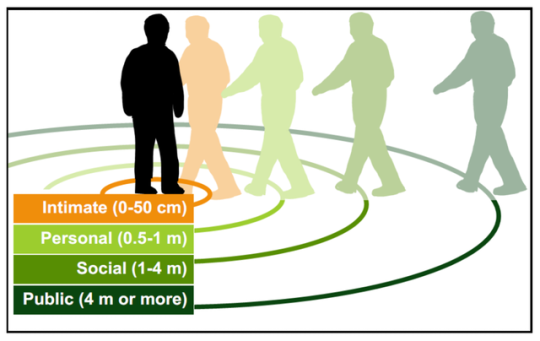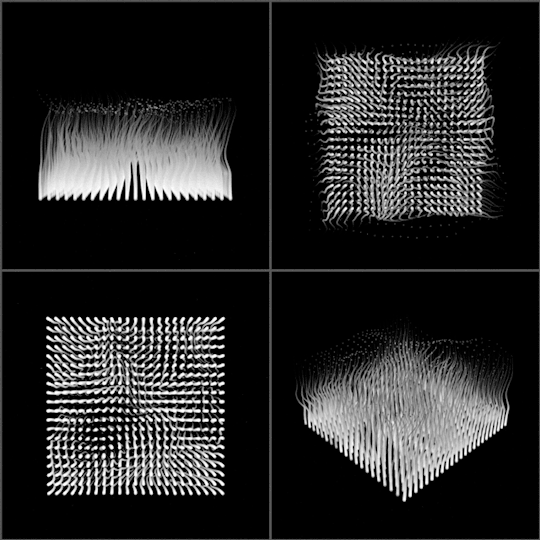#Proxemics
Explore tagged Tumblr posts
Photo

Proxemics (UP)
February 2022.
383 notes
·
View notes
Text
Proxemics and Deduction 01
Proxemics is defined as the branch of knowledge that deals with the amount of space people feel is necessary to set between themselves and others.
It’s a fascinating field that we, as deductionists, pull from on a daily basis whether we’ve been aware of it or not. If you see two people walking together, how do you gauge their relationship? Lovers, family, friends, colleagues, mortal enemies; all options, along with many more. There are quite a few scenario-specific examples, such as coworkers carrying the same identification tag, or a couple each tending to a stroller, but without fail, as a supplementary measure, or more often, as an introductory observation, we fall to proxemics. We look for levels of comfort, and one of the best ways to gauge that is physical closeness. Proxemics is one of several modes of nonverbal communication, ranging from something as simple as touch (haptics), to something as obscure as use of time (chronemics).
To explain proxemics in its most concrete state, we can reference Edward T. Hall’s interpersonal distances of man.
Imagine four concentric circles, in the center, a person. The first three circles are at 4, 8, and 12 feet respectively. Now add one more circle at 1.5 feet. From nearest to farthest, you have the intimate distance, personal distance, social distance, and public distance. Each of these measurements is used to represent the acceptable levels of closeness in various situations. It is important to note that Hall’s model, and thus Hall’s denoted application, is limited to Western ideals of social conduct. While these same measurements may not fully apply cross-culturally, all human-hosting spaces will model some form of proxemics. There will always be bounds between intimate, personal, and public space, but occasionally, they will be marked at different points. The difference between a friend and a colleague may be a matter of a few inches, and yet breaching that unspoken rule, can cause immense discomfort. Gauging this space, or lack thereof, is a major aspect of social deduction. It’s one of the first behavioral observations we utilize as deductionists, both new and old.
Before marital status, even before handedness, we have social connection. We all see it, I would venture to say we intuitively understand it, so much so that the lines between observation and deduction begin to blur.
The basics are in the textbook application, but there’s much more to proxemics than reciprocal relations. What about the colleague who’s getting a little too close for comfort? The wife who’s preparing for an imminent divorce? The regular with the irrational phobia?
Deduction, in many ways, is best dissected through deviance.
Proxemics sets a baseline for us to observe and through this baseline, enables us to detect changes. These changes speak volumes. To take the first example. You notice two coworkers behind the counter in a cafe. Their relationship status is unknown - simply colleagues, barely acquaintances, best friends - it's unestablished to you. You watch them interact; there’s limited camaraderie, few words exchanged from one, a few too many from the other. Is worker B simply over communicative, or is there more to it? You see B encroach on what would be appropriate for a colleague (social/personal depending on the available space - which is something I’ll touch on in a moment), but A steps away, leaving B in the next available concentric circle. This is something we would likely notice without the knowledge of proxemics, but would be unable to categorize beyond a vague ramble about “intuitive social knowledge”. By referencing an established baseline we streamline the observation and solidify it in the process, creating a new building block to jump off of. “Individual A looks uncomfortable” turns into, dare I say, a mathematical reference point for any and all future behavior.
It is important to acknowledge that this particular example is not representative of Person A’s baseline. It is also important to acknowledge that not every person follows the same baseline, and that certain situations will inherently alter expected baselines. Let’s take the example of a very small area behind the counter in this imaginative cafe. Informal colleagues will likely be forced into what would be considered personal or even intimate space. Proxemic expectations change not only cross-culturally, but by environment. The best way to understand proxemic norms in non-standard situations, is to spend some time observing many people who are exposed to that specific situation. If you simply go off how you would feel in that situation, you are setting a baseline with a possible bias. People tend towards environments they're comfortable with. There is, after all, a reason they’re behind that counter and you’re not.
Now, one might argue that if the proxemic standards are constantly changing, the applications of the specific measurements are all but useless. While it is true that the baselines are constantly changing by environment, there is an overarching standard. When the space is provided to do so, people will revert to defined patterns. And in situations where the space is not available, using this model, you can deduce a whole host of things with the proportional proximal input and subsequent behavior. Personality, relationships, levels of comfort and discomfort are all vital bits of information.
One interesting morsel I feel like throwing in here is the fascinating subject of lines. Lines, queues, whatever you want to call them are one of the best places to observe shifting proxemics in action. As more people enter the queue (when the space is confined) the spaces between individuals will decrease until they reach a social breaking point, at this point the line will turn, often veering out of the designated queue area. Onto another cafe example (can you tell I got coffee this morning). One person walks up to the register. At this point, the only proximal opportunity is between the cashier and the patron - which is generally defined by the width of the counter between them. Now, another person walks up and starts a line - depending on this individual’s personal proxemic preference, the standard in the line is set. The next person who joins the line will tend to follow the set amount of spacing, and the next person, and so on, as space allows. The patrons up ahead, uncaring of what’s going on behind them, will typically not adjust their positions, leaving a continuous theme of compression as the line progresses, until someone breaks and opts to turn the line. If there is no way to turn, that same slinky effect will move its way back up the line as people become aware of the discomfort behind them. I observed this in action this morning while waiting at my local cafe. Because there is continuous movement, the comfort of the line is rarely at the forefront of anyone’s mind; their priority is to reach the front, not be optimally comfortable while waiting. If, for example, people were queuing onto a bus (which for some reason didn’t have seats) and had to stand there for a couple hours, everyone would evenly disperse. In scenarios with movement, one person’s typically insignificant social preference has a domino effect on those behind them. There’s an observable push and pull of conscientiousness and the introversion-extroversion spectrum. We adjust subconsciously to the line’s collective consciousness, bow down to the social conduct overlord, and occasionally get squished in the process. Take some time to observe this phenomenon next time you’re waiting. Be a menace and try standing too close or too far and watch how uncomfortable you, and possibly others, get. Next time you're first in line, set a weird tone, but remember, with great power comes great responsibility.
The last topic I’m going to be touching on is something I can find absolutely no research on (great intro, I know), so bear with me. I’d like to discuss proxemics in terms of the inanimate object - something that I’m very poorly defining, but I believe works in the context of this article. I’ve been taking notes on this subject for some time, but only in my own geographical area. It’s proved wildly effective at predicting where people will go, so I took some time this morning to watch live CCTV footage of city walkways in other cities, both in the US and nationally (London, Oxford, and Tokyo). This is simply anecdotal, but through this limited observation it became clear to me that people will walk in the middle of their perceived space, cross-culturally. This sense of available space changes depending on the presence of a roadway, varied storefront structure, as well as other people. If there is no one coming towards them, people will tend towards the middle of the walkway, often veering slightly towards the right or left side (driving/passing side of the given country). Individual patterns can answer questions about openness, day to day activities, and conscientiousness. For instance, a person on a walkway with no one coming towards them who is walking distinctly on the right side (in a right-driving country) may be very high on the conscientiousness scale, and/or their typical routine involves walking among many people. These sorts of deductions can be further parsed using other observations.
If we accept the premise that people tend towards the middle of their perceived space (which, if other people are approaching, may be one side of a walkway - effectively leaving their “middle” veered to one side), then deviance will usually stem from moving towards, or away from, something. There are a lot of fun applications to this, for instance, deducing how much of a hurry someone is in based on how likely they are to go for the most acceptable path or the quickest path, at baseline. For example, I tend to opt for the most acceptable/safest path, I have high conscientiousness and high neuroticism according to the OCEAN model. But today, I jay-walked through a busy street to get somewhere before my order was ready. This is an example of considering the safest path. Considering the most acceptable path has some predictive applications. As I was taking a break between shifts the other day, I noticed that people who wanted to walk into a store changed their path relatively far in advance. In this case, they were heading towards something. I was able to easily predict which store someone might go into well up to a block away, when utilized in tandem with other observations.
Early on in my research journey I found that in videos of people walking on the street oncoming individuals were encouraged to veer away from the person filming. I prioritized finding CCTV to avoid this, but found it to be an interesting example of people changing course to avoid something. There were also a few people who veered into the camera's view. Something as simple as this may give clues to an individual's level of openness and extraversion.
In public situations where a person must veer into an oncoming flow of people to cross to their desired destination, they will often wait until they’re near adjacent to it; in a more desolate walkway, they’ll veer much earlier. Possibly charting their whole course along the less-acceptable pathway.
I label this idea as the proxemics of objects because when walking, we seem to assign objects their own personal bubbles. We don’t walk near the table line of a restaurant unless there’s a specific reason to. We tend not to encroach on their space, in the same way we consider people. Perhaps it’s more for our comfort than the objects’, or perhaps we’ve all been traumatized by the videos of people dressing up as bushes. Either way, I found it interesting enough to throw in here, and if you’re seeing this, you found it interesting enough to read (yay). I’ll be further exploring the topic of object spatial awareness in a future article I have planned.
Thank you for reading - below are some relevant articles -
https://www.sagepub.com/sites/default/files/upm-binaries/11826_Chapter8.pdf
https://thereader.mitpress.mit.edu/understanding-personal-space-proxemics/
Hall, Edward T., et al. “Proxemics [and Comments and Replies].” Current Anthropology, vol. 9, no. 2/3, 1968, pp. 83–108. JSTOR, http://www.jstor.org/stable/2740724. Accessed 6 Dec. 2023.
#deduction#deductive reasoning#sherlock#a study in sepia#sherlock holmes#social science#proxemics#social psychology
30 notes
·
View notes
Text
Writing Nonverbal Communication: Proxemics
After some research, we now know that nonverbal communication makes up 93% of all the messages we interpret when communicating with one another. “[Dr. Mehtabian] concluded that the interpretation of a message is 7 percent verbal, 38 percent vocal and 55 percent visual,” and this means an important element of communication can be forgotten when we are writing novels.
What is proxemics?
Proxemics, one of the aspects of nonverbal communication, is the study and use of physical distances between people who are interacting. There are four zones in which people are categorized within this study.

Intimate: This the closest distance you can get to someone. This space should be reserved for only those whom you have close relationships (partners and family).
Personal: This is the second closest space you should take up with someone whom you have a personal relationship but aren’t so close with that you want them within touching distance (friends and family).
Social: This is for people you know, but are not close with at all (colleagues, teachers, other parents at a school meeting, coworkers, etc.)
Public: This is the zone for those without any prior contact with and are still strangers to you.
Are these spaces always a specific distance?
Nope! In general, all cultures will have different opinions on their personal zones. For example, people will have smaller proxemic zones in Argentina, whereas Romania will have larger distances in their zones. Though, this does go beyond cultures as well. People who consider themselves to be more introverted will have larger circles to keep people at a distance, while extroverts prefer to be closer to those they are speaking with. Some people, such as people with autism, may opt to never have anyone in their intimate zone, in which case, all four zones would get shifted to whatever distance is most comfortable for them to interact with others, and have a dead zone around them that no one can enter.
How does this help me write?
Conveying targeted information into your writing helps with suspense, subtlety, and subtext. Readings do not like to be told what is happening, they like to figure it out themselves. This is a key element when faced with the classic writing advice “show don’t tell”. This opens up a whole new world for writers when utilized.
Let’s look at some examples of how this can improve your writing:
If your antagonist walks up to your protagonist, directly forcing themselves into the intimate zone, this could be considered a threat and cause fear, anger, or tension. Even if they use kind words, with a sweet smile and demeanour, it will not change the fact they they intentionally crossed into the protagonist’s intimate zone without permission.
A shy classmate joins others for a group project but chooses to sit in the seat directly next to the protagonist instead of other empty seats. Does this mean the classmate likes your protagonist, trusts them, feels most comfortable around your main character? That’s up to you to decide, you can convey this with their next actions, little to no dialogue needed.
After a fight between a couple, one joins the other to watch television after cooling off for a while, but still aren’t speaking with each other. Do they sit next to each other, meaning despite the fight, they still want this relationship to work, and enjoy the other’s company. Or do they sit on the opposite side of the couch to keep as much distance between them as possible, meaning they are still angry, processing, and don’t want their partner too close to them.
A student runs directly into another student’s intimate zone to show them they got an A on their test. If neither takes a step back, this likely doesn’t bother either of them because they have a very close relationship, and don’t mind having each other in their most intimate zones.
There are many ways that proxemics can be used in writing to show types of relationships, intimacy, fear, cause suspense or suspicion, and more when writing. Start by practicing little by little and reviewing places where you can add in proxemics around your dialogue to improve the overall message you are trying to convey without telling the readers what is happening.
Happy Writing!
#creative writing#writer#tumblr writers#writing#writeblr#writerscommunity#fiction#writing advice#writing community#novel writing#Proxemics#nonverbal
47 notes
·
View notes
Text
So my glasses broke yesterday, and I'm not sure yet when I'll be able to get a new pair. Now I can only see things clearly if they're closer than ten inches to my face. I keep thinking of this in terms of Edward T. Hall's proxemics - I can only see details within my own intimate space. And it's kind of an interesting awareness exercise. What enters my intimate space, on a usual day? I'm hyper-aware of that now because they're the only things I can see in detail. Are they the things I want there? How often is it another person? How often is it something besides my phone? I'm pleasantly surprised at how often it's food, because it's framing eating as an intimate activity, and that's not the way I usually think of it but it makes sense, and I'm enjoying thinking of it that way, and it's probably a good way to think of it.
3 notes
·
View notes
Text
Looking for communication (studies) nerds
Hello! I have a BS in Communication (Intercultural) and I am looking for a few fellow nerds in the field. Do you like to talk about proxemics, group think, muted group theory, culture shock, high and low context cultures and how they differ, when public communication becomes mass communication, organizational culture and more related theories and topics and concepts? Are you fascinated by real world examples for these theories and concepts? what about fictional world/story examples? Do you just like to bullshit and rant about the concepts for fun?
I am creating a discord group for like minding fellow nerds, and one of the biggest groups I would like to have join is communication (studies) nerds! Also people who are queer, neurodivergent, have chronic physical and/or mental health issues, and like stories (reading them and/or writing their own!).
For now, though, I would really love to connect with some communication people! Send me an ask or a private message if you are one and would like to connect! I’ll reply with a link to the discord (its still a WIP).
Please reblog this so it breaks containment! Thanks.
#communition#communication (studies)#intercultural communication#group communication#queer#lgbtq+#neurodivergent#chronic pain#chronic pain community where you at?#speak up mates#proxemics#group think#muted group theory#muted group my beloved#please i want to bitch about organizational culture sometimes ya know?#with people who study it seriously#and academically#and not like casually?#i know there other people out there who do!#you exist!#where you at?
3 notes
·
View notes
Note
I’m studying proxemics right now in college (comm major 🤪) and intimate space is actually more widely considered to be from skin contact (0 inches) to 18 inches, which means that J2 LIVE in each other’s intimate space.
(Personal space is 18 inches to 4 feet.)
Contrary to what you might think, intimate space is not just reserved for people in romantic relationships. We typically see it most in romantic relationships, but it’s just people who are very emotionally close to each other.
So obviously, that means J2 have a very close emotional bond, which is why they’re so comfortable being all up in each other’s 18 inches all the time. 🥹 They trust each other more than typical best friends might (esp male best friends, bc toxic masculinity), and probably know each other inside and out.
They went through a lot together over those 15 years, and have now been friends for almost 20 years. I think it’s safe to say they know each other’s deepest darkest secrets, biggest desires, goals, feelings about things, etc. I would venture so far as to say they can probably tell how the other is feeling without needing to verbally communicate, kind of like Sam and Dean.
Proxemics is a nonverbal communication channel. What they’re communicating to each other constantly is that they’re there for each other, they’re not leaving, I’ve got your back, I love you.
And to everyone else, they’re communicating that they are one of the most important people in each other’s lives.
I have seen talking about Jensen and Jared and "myth of personal space" I do not understand? Why is it myth? Is it because of standing close or touching or ? (Sorry for my bad English)
Your English sounds fine to me!
J2 and the Myth of Personal Space is a funny tag people use because of the things you mentioned plus so much more. There is a whole field of research called proxemics that deals with how we use the space around ourselves. We all tend to keep a bubble of personal space around ourselves. We have a tendency to move away from people who invade our personal space. Unless you’re talking about these two:

I mean, really you can just look at how they choose to stand and sit. It’s always right next to each other, usually with at least some part of them touching- their arms, shoulders, or knees.


And then there’s the constant touching too.“There is a primal reassurance in being touched, in knowing that someone else, someone close to you, wants to be touching you. There is a bone-deep security that goes with the brush of a human hand, a silent, reflex-level affirmation that someone is near, that someone cares.” (That’s from a book by Jim Butcher and it reminds me of them.)


So you can see why some people feel like they make the idea of personal space into a myth. They certainly don’t need any.

Btw- generally speaking, personal space is anywhere from 6-24 inches around you. Anything closer than 6 inches is called intimate space. But they clearly don’t even need that little gap in between them.



And they’re always so casual about it too. Like it’s no big deal at all or they don’t even notice the’re doing it. They should really be a case study for those proxemics researchers.
1K notes
·
View notes
Text
That post that went around about how on screen intimacy has been killed by the widescreen format is actually so correct. I'm supposed to believe these two are in love? Why are they across the room from each other? Why aren't they leaning so far over that table between them that it looks like they are trying to clip through it. Pack those bitches in there. More space just pack in more bitches. I don't care. Make people up in each other's personal space again for fucksake.
#movies#tv#video game cut scenes#proxemics#was i the only bitch who paid attention to the proxemics portion of film school#this applies solely to fiction on screen relationships do not just start getting in irl people's personal space without permission
1 note
·
View note
Text
Inclusive Design; Ergonomics, Anthropometrics, Proxemics
Definitions
Inclusive Design – ‘A design process that makes places usable by everyone, regardless of age, disability and circumstance.’
Ergonomics – ‘The study of people’s efficiency in their working environment.’
Anthropometrics – ‘The science of measuring size and proportions of the human body.’
Proxemics – ‘The branch of knowledge that deals with the amount of space that people feel it necessary to set between themselves and others.’
Inclusivity is the important factor of a design which ensures that the design is a comfortable and usable space for anyone of any age, religion, culture, ability and size.

Ergonomics in the built environment is where designers look at spaces and create designs and dimensions based on people. As Dul says in ‘Ergonomics for beginners’, “the word ergonomics is derived from the Greek words ergon (work) and nomos (law). In several countries the term ‘human factor’ is also used”. As the word ergonomics can also be referred to as human factor, it further iterates its importance and connection with peoples everyday lives. Dul further goes on to say that ergonomics within design allow and promote, “comfort and efficient performance at work and in everyday life”.

Anthropometry is explained by Julius Panero in ‘Human dimension and Interior space’ as a process of design which uses the dimensions of the human body to determine dimensions and spaces. Anthropometry uses the dimensions of human bodies in order to design and construct spaces which are inclusive for anyone.
Anthropometric tools: - Height - Length and circumference of body segments - Bone diameter - Skin thickness - Weight

Proxemics is different to ergonomics and anthropometrics as it can’t always be measured based on human dimensions, it’s more unseen and based on personal opinions. Proxemics is looking at personal space. It can be a tricky one to design by as everyone has different ideas of personal space – some may be happier to have people closer to them than others. Julius says “people boundaries don’t begin and end with skin”, which further emphasizes the difference between Proxemics and Anthropometry and Ergonomics. Proxemics is more than creating an inclusive and usable space for everyone, it’s about ensuring comfort and space between people.
References
“Adult Human Body Dimensions - Ventral .” Blogspot.com, archipaedia-archipod.blogspot.com/2011/12/anthropometrics.html.
BD Editors. “Anthropometry.” Biology Dictionary, 16 May 2017, biologydictionary.net/anthropometry/.
Dul, Jan, and B Weerdmeester. Ergonomics for Beginners. London, Washington DC , Taylor & Francis, 1993, pp. 1–4, archive.org/details/ergonomicsforbeg0000dulj_f6p7/page/2/mode/2up.
“Ergonomics Helps Us Harmonize Things That Interact with Humans Regarding Our Needs, Abilities, and Limitations.” MarketBusinessNews.com, marketbusinessnews.com/financial-glossary/ergonomics-definition-meaning/.
Fowler, F G, et al. Concise Oxford English Dictionary. New York, Oxford Univ. Press, 2008.
Panero, Julius, and Martin Zelnik. Human Dimension & Interior Space : A Source Book of Design Reference Standards. New York, Whitney Library of Design, 1979.
“Proxemics Illustrated.” What-When-How.com, what-when-how.com/paramedic-care/therapeutic-communications-principles-of-clinical-practice-paramedic-care-part-1/.
“What Is Inclusive Design.” Www.sensorytrust.org.uk, www.sensorytrust.org.uk/resources/guidance/what-is-inclusive-design.
Wikipedia Contributors. “Inclusive Design.” Wikipedia, Wikimedia Foundation, 24 May 2019, en.wikipedia.org/wiki/Inclusive_design.
Whilst researching the different aspects of inclusive design (ergonomics, anthropometrics and proxemics) I have realised that there are so many more factors to inclusive design than just minimum dimensions. I have learnt that the width of stairs, hallways or lifts are just the basics of inclusivity and that within the design process we must consider a much wider variety of factors.
Whilst reading J.Dul’s ‘Ergonomics for beginners’ I agreed with his view that factoring in ergonomics within design is vital to ensure comfortable and sufficient designs. I further agree that ergonomics is an interdisciplinary factor – it is important throughout all fields of design. From buildings to fashion to toys, ergonomics will always be a relevant and important factor.
0 notes
Text
Abstraction, Expression, and Sonification
Abstraction, Expression, and Sonification #photography #abstractart #music
Conflict by Maria L. Berg 2023 I looked at expression as an abstract noun back at the beginning of my study in April of 2022, and created a facial expression out of wire for my images. But today, I’m exploring “a manifestation of an emotion, feeling, etc., without words” and communication of emotion through art. In Photography and the Art of Seeing by Freeman Patterson, he says, “Once you have…

View On WordPress
#abstract art#abstract photography#light-forming photography#proxemics#RNLN#sonification#synthesis#waffling
0 notes
Text




#interview with the vampire#iwtv amc#iwtv season 2#iwtv#iliad 23.83-4#the iliad#iliad 23#zetra#inseparable zetra#claudeleine#claudia de pointe du lac#madeleine eparvier#mlm wlm solidarity in tragedy#im meant to be writing uni assignments but ive got the tragic lesbians on my mind#claudeleine/patrochilles parallel you will kill me#the proxemics of death make me sick
9 notes
·
View notes
Text
one of the funniest things when you start studying theatre design (at our school anyway) is that u come in and for your first few scenography designs youre like im gonna use screens ,,,,, —and projection.... this is how i’m going to enhance the impact of my performance 🤯🧠💯 & then you go to theatre productions in which they use screens and projection & ur like All My Teachers Were Right This Sucks Severe Ass
#^so says guy who crucially is using screens in his concept rn#but its different bc the screen itself is the medium as opposed to enhancing theatre cause like the thing is#and this sounds fucking pretentious until you actually pay attn to it#but the thing is that when ur trying to balance screen/projection with live action ur projection is going to eat shit absolutely every time#nothing beats the tension of live theatre & if youre attempting to mix it too often it'll end up in comparison#(this is if you use the projection cut n dry i once saw a performance where the projection was done really well actually#but it wasnt so much a balance btwn the two things as it was like. certain scenes were a video the performer just danced along to#and it was more so about his individual experience vs the experience others have that he cant articulate on his own#it was rly fucking good it was called the history of the korean western theatre it was stellar)#but also like the thing i just left was an opera that used screens practically instead of doing anything on the stage#which is SO bewildering to me#there were a few more things wrong with it but the biggest thing to me was like#in these videos they were showing (during the performance of the scenes) it was basically the scene that was playing#except with an attempt at a real costume and somewhat more of an effort when it comes to proxemics#whereas on stage itself it was black clothes (not even interesting shapes) and people talking At each other#which not only does this become a really boring back drop for an even more boring live action part (which is nevertheless still more#compelling than the video) they were also speaking the lines in the videos just with the sound removed#so often it felt like you were watching out of sync videos#and also like even the costumes in the videos were boring as hell bc it was just patterns printed on top of fabric#which can work at times but not like this it was all so .... 2 dimensional but like quite literally#its not even that bad to be honest like ive seen far worse things its just a lot more egregious cause its unreal expensive and also doesnt#even seem to try#(+ im quite sure the director of this opera is my theatre history professor's dad & i am yelling & screaming imagining the family dinners)#(like all the actors were also white & it was the story of the indian queen which is abt mexico & peruvian incas & my prof is like. so#hyper socially aware this wouldnt ever ever ever fly with her#plus she's really creative & we saw a play by her last semester and its night & fucking day love)
6 notes
·
View notes
Photo


Proxemics
105 notes
·
View notes
Text


Note the space between Gale and Curt. It’s as if they wanted to illustrate the difference between the Intimate and the Personal zone 😄
the fact Gale keeps his arm outstretched on the back of Bucky’s chair the entire time they’re in the pub in episode 2 and the fact Bucky sits with his back angled toward Gale as if tucked into the crook of his shoulder are two very important somethings that can be so personal
186 notes
·
View notes
Note
How do I write basic movements, I'm not a native speaker so it gets hard for me to define basic bodily movements. Even if it's as simple as reaching out and taking something off the counter
Facial expressions, gestures, and eye gaze are often identified as the 3 major types of body language, but other aspects such as posture and personal distance can also be used to convey information.
A few common gestures & their possible meanings:
Pursed lips. Tightening the lips might be an indicator of distaste, disapproval, or distrust.
Lip biting. People sometimes bite their lips when they are worried, anxious, or stressed.
Covering the mouth. When people want to hide an emotional reaction, they might cover their mouths in order to avoid displaying smiles or smirks.
Turned up or down. Slight changes in the mouth can also be subtle indicators of what a person is feeling. When the mouth is slightly turned up, it might mean that the person is feeling happy or optimistic. On the other hand, a slightly down-turned mouth can be an indicator of sadness, disapproval, or even an outright grimace.
A clenched fist can indicate anger in some situations or solidarity in others.
A thumbs up and thumbs down are often used as gestures of approval and disapproval.
The "okay" gesture, made by touching together the thumb and index finger in a circle while extending the other three fingers can be used to mean "okay" or "all right." In some parts of Europe, however, the same signal is used to imply you are nothing. In some South American countries, the symbol is actually a vulgar gesture.
The V sign, created by lifting the index and middle finger and separating them to create a V-shape, means peace or victory in some countries. In the United Kingdom and Australia, the symbol takes on an offensive meaning when the back of the hand is facing outward.
Crossed arms might indicate that a person feels defensive, self-protective, or closed-off.
Standing with hands placed on the hips can be an indication that a person is ready and in control, or it can also possibly be a sign of aggressiveness.
Clasping the hands behind the back might indicate that a person is feeling bored, anxious, or even angry.
Rapidly tapping fingers or fidgeting can be a sign that a person is bored, impatient, or frustrated.
Crossed legs can indicate that a person is feeling closed-off or in need of privacy.
Open posture involves keeping the trunk of the body open and exposed. This type of posture indicates friendliness, openness, and willingness.
Closed posture involves hiding the trunk of the body often by hunching forward and keeping the arms and legs crossed. This type of posture can be an indicator of hostility, unfriendliness, and anxiety.
The term proxemics, coined by anthropologist Edward T. Hall, refers to the distance between people as they interact.
Just as body movements and facial expressions can communicate a great deal of nonverbal information, so can the physical space between individuals.
Hall described 4 levels of social distance that occur in different situations:
Intimate Distance: 6 to 18 inches. This level of physical distance often indicates a closer relationship or greater comfort between individuals. It usually occurs during intimate contact such as hugging, whispering, or touching.
Personal Distance: 1.5 to 4 feet. Physical distance at this level usually occurs between people who are family members or close friends. The closer the people can comfortably stand while interacting can be an indicator of the level of intimacy in their relationship.
Social Distance: 4 to 12 feet. This level of physical distance is often used with individuals who are acquaintances. With someone you know fairly well, such as a co-worker you see several times a week, you might feel more comfortable interacting at a closer distance. In cases where you do not know the other person well, such as a postal delivery driver you only see once a month, a distance of 10 to 12 feet may feel more comfortable.
Public Distance: 12 to 25 feet. Physical distance at this level is often used in public speaking situations. Talking in front of a class full of students or giving a presentation at work are good examples of such situations.
Source ⚜ Writing Resources PDFs ⚜ Some Additional Resources:
Anatomical Movements
Types of Body Movements
Human Body Movements
Hope this helps with your writing! Definitely have trouble with this at times as well.
#anonymous#writeblr#writers on tumblr#writing reference#spilled ink#writing prompt#creative writing#literature#dark academia#anatomy#body language#body movement#gestures#writing resources
653 notes
·
View notes
Text
Please Don't Be In Love With Somone Else
Damian Priest x You Oneshot
TW: Swearing, loss of a loved one
Summary: One gesture from Priest finally pushes you to make your move.

“That bastard!” You huffed out quietly as you lifted your ring gear out of your bag. You didn’t know whether to scream or cry. You ex had left you one last parting gift. You’d been apart for eight months now but he finally finished collecting your stuff at the weekend, you’d let him into the house and gone out with your girls for the day. You didn’t expect him to rummage through the wrestling stuff you’d packed away ready for the week ahead. You knew it was Rhea from her voice as she approached you asking what was wrong. You held out your gear in front of you and looked over your shoulder as you watched Rhea’s mouth form an ‘o’ shape. You brought your closed fist to your mouth to help control the anger that wanted to burst out of you.
“The piece of shit” Rhea breathed out shaking her head. It was ruined. There was no way it was going to be fixable.
“Can you believe he did this?” You sat down on the bench deflated and clutching onto your ruined gear. He had taken scissors and cut holes into it.
“Rhea, this was the last set she made before she passed.” Your words trembled out of your mouth, the tears starting to trickle down your cheeks hugging the gear close to you as you thought about your sister.
“Why would he do this?” You sobbed as Rhea pulled you into her embrace, she soothed your back and allowed you to cry. Rhea was the complete opposite of her on screen character, in reality she was humble, caring and nurturing.
“He’s a jealous selfish prick, that’s why!” Rhea carefully peeled you off her, wiping away your tears then placing her hands on your shoulders for reassurance.
“Hey, we will figure this out okay. Right now we need to find you some gear otherwise you're gonna be a naked girly.” You half heartedly smiled and giggled at Rhea’s attempt to cheer you up.
“Hah you laughed, that means we can do this!” She squeezed you tightly before holding your hands and helping you up and heading out of the locker room.
You were sitting in the styling chair, your hair being put into space buns when his soothingly low pitched voice came from behind you.
“Do you mind giving us a minute?” Priest was now standing in front of you; his usually cheeky smile was this time full of sympathy.
“I told you I should have stayed at the house” He approached you in an intimate proxemics as the palm of his hand rested on your cheek. He tenderly manoeuvred your face side to side and up and down scanning your face. His eyes eventually settled on yours and you too looked up at him. Your heart always did this when he looked at you, touched you,it would rapidly beat and then hurt as if it had burst into a million tiny little hearts that floated in your insides. His hand fell from your cheek and you felt instant withdrawal symptoms.
“He didn’t hurt me. I went out with the girls” You spoke trying to start a conversation.
“Good. Rhea told me what he did to your gear, I’m sorry Y/N” “It’s not your fault. Besides, there's no point getting upset about it anymore, I can’t fix it.”
“Well I do believe I have the perfect solution.” He wiggled his eyebrows and held a smirk as he pulled out a shirt from his back pocket and threw it at you. It was one of his merch t-shirts, it was cut and shaped to fit like ring gear. He could always put a smile on your face.
“You want me to wear this?” You raised your eyebrows and smiled widely as you held it out.
“Me? Personally, I'd prefer it if you wore nothing. “ Damian whispered into your ear as he pulled you off the chair and into him. He carrassed his fingertips along your arms until he reached the straps of your tank top and gently tugged them down revealing your collarbone. He then traced his fingers across your chest slowly as he made his way up your neck and then onto your lips where his thumb parted them as he pushed your bottom lip down finally resting his tips on your chin. You wanted it badly, to feel his lips on yours.
Damian had always been a good friend to you, you were the last two people at the bar chatting the night away. He was the one who stood by you and held your hand tightly as you mourned your sister at her funeral. He was the one who lifted you up and spun you around in celebration as you won your first championship. Things had changed between you one evening after the third and final time you and Bron had broken up. Damian had escorted you back to your hotel room, the two of you just stood in front of the door in silence staring into each other. You didn’t want him to leave, his presence was comforting. You had one hand on the door handle but refused to open it until Damian had closed the gap between you and placed his hand on top of yours, twisting the handle and opening the door. He was so close to kissing you every part of him wanted to do it for years. He could see the breathing in your chest rise and fall as he stood this close to you.
“Do you want me to stay with you?” He asked and you nodded in return. He had never forgotten watching you dress down to your bra and pants as you climbed into the bed. Damian had never said anything about how he had felt all these years, cause you’d always been in love with someone else.
“You’re a tease Priest” You hushed and smiled pushing off of him.
“No, what will be teasing is you performing in my shirt.” He leaned beside you grabbing the shirt off the chair and holding it to your chest.
“So I won't wear it then..” You pushed his hand away and sat back down in the chair as Lydia started on your hair again. “You will wear it, trust me.” He placed the shirt on the table beside you and walked away.
“I hate it when you’re right!” You shouted out, he responded by throwing up a love heart.
A few days later
There was a present on your locker room bench. You picked up the card to read the message.
I will always be there to help you fix problems.
D.P. x
Placing the card down you unwrapped the present. Gently unfolding the outfit you realised it was a version of your ring gear. As you began to observe it you realised that the gear your sister had made you was used to help make this one. You brought it close to you and hugged it as if it was the most important thing to you. You had assumed someone had thrown it out when it had gone missing. It wasn't until you read back over the card it registered in your brain who had this made for you. Grabbing your phone from your back pocket, you open your messages.
Y/N: Where are you?
Instantly you had your reply.
DP: Been waiting outside the women’s locker room since Rhea told me you were there.
You dropped your phone and made your way over to the door. After one big release of breath you opened the door to see him standing on your left, leaning against the wall wearing the most attractive and warm smile. It felt as if this moment as you stood in front of him were happening in slow motion, it felt like this moment was what would happen in a film, one grand gesture and all the palpable tension between two people would finally unavoidably explode.
With a quiet volume and shaky tone you asked him “did you do this?” holding up the gear in your left hand.
“I mean unless you know another DP?” He shrugged his shoulders. You leapt, physically leapt into Damian’s arm as you pulled him down into your frame and kissed him. He kissed you with passion as he needily roamed his hands down your back, along your thighs, gripping onto your neck before finally settling on the apples of your cheeks. Pulling away he leaned his forehead on yours.
“That was a nice thank you.”
“Thank you Damian. This is the most thoughtful gift ever. Really.”
His hand settled on your lower back as yours clasped around his neck.
“As much as I love how happy this has made you, I’m kinda mad I don't get to see you wear my shirt in the ring again. I look good on you” You rolled your eyes playfully to which Damian responded by planting kisses along your neck.
“Just for you I’ll wear it tonight... In and out of the ring.” You flirtatiously bit your lip.
With a growl of temptation Damian kissed you. After a few delicate kisses Damian stopped and looked at you seriously.
“Y/N, on a serious note I’m so glad it's finally me.” “What do you mean?” “You’ve always been in love with someone else.” After a brief moment of silence Priest pushed a strand of your hair behind your ear to capture a full picture of you up close in this vulnerable state.
“I won't be like him Y/N. I hope you know that.” You nod your head in acknowledgement.
“Please don’t be in love with someone else again.” You intently gazed into his eyes letting the biggest smile spread across your full lips.
“Never.”
Damian lifted you up to wrap yourself around him, his hands tangled in your hair as he fervently kissed you again.
#damian priest fanfic#wwe damian priest#damian priest wwe#damian priest#damian priest imagine#damian priest x you#damian priest oneshot#damian priest fanfiction#wwe#wwe judgement day
204 notes
·
View notes
Text
The classical proxemic theory (Hall, 1966) classifies interpersonal distance into four categories:
Public distance, maintained in impersonal settings (above 210 cm)
Social distance, maintained in interpersonal, but formal settings (122-210 cm)
Personal distance, maintained in interactions with friends and family members (about 46 to 122 cm)
Intimate distance, maintained only in closest relationships (from 0 to 46 cm)
No wonder that Aziraphale and Crowley had to be eventually separated by force — otherwise the speed with which they were closing their intimacy gap would render them useless against the Second Coming.




#good omens#good omens meta#ineffable husbands#aziraphale#crowley#the good omens crew is unhinged#everything has a meaning#intercultural communication#through angelic and demonic lens#yuri is doing her thing#procrastinating again
130 notes
·
View notes